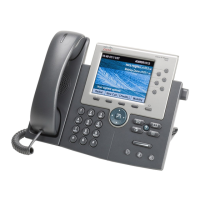3-13
Cisco Unified IP Phone 7965G and 7945G Administration Guide for Cisco Unified Communications Manager 6.0
OL-12650-01
Chapter 3 Setting Up the Cisco Unified IP Phone
Configuring Startup Network Settings
–
Mute—Phone is downloading images from the TFTP server.
–
Speaker—Phone is writing images to its flash memory.
4. The phone screen displays the Cisco Systems, Inc., logo screen.
5. These messages appear as the phone starts:
–
Verifying load (if the phone load does not match the load on the TFTP server). If this message
appears, the phone start up again and repeats step 1 through step 4 above.
–
Configuring IP.
–
Updating CTL.
–
Updating Locale.
–
Configuring CM List.
–
Registering.
6. The main phone screen displays:
–
Current date and time
–
Primary directory number
–
Additional directory numbers and speed dial numbers, if configured
–
Softkeys
If the phone successfully passes through these stages, it has started up properly. If the phone does not
start up properly, see the
“Resolving Startup Problems” section on page 9-2.
Configuring Startup Network Settings
If you are not using DHCP in your network, you must configure these network settings on the
Cisco
Unified IP Phone after installing the phone on the network:
• IP address
• IP subnet mask
• Default gateway IP address
• TFTP server IP address
You may also configure these optional settings as necessary:
• Domain name
• DNS server IP address
Collect this information and see the instructions in Chapter 4, “Configuring Settings on the Cisco
Unified IP Phone.”
Configuring Security on the Cisco Unified IP Phone
The security features protect against several threats, including threats to the identity of the phone and to
data. These features establish and maintain authenticated communication streams between the phone and
the Cisco
Unified Communications Manager server, and digitally sign files before they are delivered.

